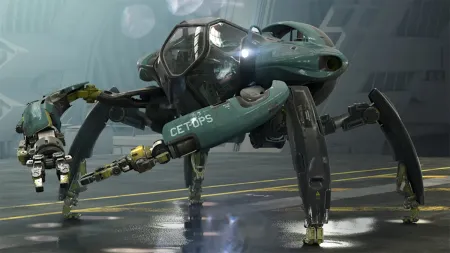



Biomimicry perhaps shines the most in creative media, where the level of imitation is substantially large. In Horizon: Zero Dawn, the most recognizable aspect of the game is the Machines: robotic organisms that imitate not only their organic inspiration in appearance but also their behavior. Whether it be sneaking through tall grasses to ambush a herd of unsuspecting Grazers or fending off a Sawtooth as it lunges with its metallic claws and fangs, players who engage in the open landscape of this game can observe a plethora of different Machines interacting with the environment in organic manners — albeit altered due to the setting of the game.

Another instance would be the SMP-2 Crab Suit employed by the RDA from Avatar: The Way of Water. While the screen time of this aquatic mech suit was little, the few scenes it had left a lasting impression on viewers due to its unique form that mimics… a crab. Yet, the suit does not share the limitations of its organic counterpart as it can easily glide through bodies of water when it retracts all its appendages into its chassis and moves with its inducted propellers in the rear.
The fascination with these designs in media can ultimately be boiled down to how efficiently artists and designers can replace bones and flesh for steel and cables without compromising the familiar identity of the animal it was inspired from. While biomimicry may not be as grandiose in real-life applications compared to the creative liberties done in media regarding aesthetics, it nevertheless molds the form that the design will take.
References:
[1] https://www.leonardodavinci.net/flyingmachine.jsp
Additional Leonardo da Vinci’s Info: https://huckleberryfineart.com/decoding-natures-secrets-lessons-from-leonardo-da-vincis-observations-of-birds/
[2] https://www.power-technology.com/features/biomimicry-wind-turbine-tubercle-heliotrope-power-technology-research-design/?cf-view&cf-closed[3] https://uxdesign.cc/shinkansen-the-bullet-train-inspired-by-kingfishers-bf6173cc5eae
[4] https://blog.playstation.com/archive/2017/02/24/the-making-of-horizon-zero-dawns-machines-as-told-by-guerrilla-games/
[5] https://variety.com/2022/artisans/news/avatar-2-mechs-vehicles-production-designers-1235473422/


6 Comments. Leave new
I enjoyed reading this post! Like others have said, it is a very unique aesthetic and something I have not been able to put a name to before. I think the point you made of how biomimicry frequently yields optimal, yet unexpected results, is exciting. Are there any other examples of human designs and their natural counterparts you could include? One that comes to mind is the side by side of a B-2 Spirit and a Hawk. Potentially also the concept of shark skin and tech suits in swimming (which have actually been banned in the Olympics for the significant advantage they supply).
Certainly, I found more examples during research but did not include the concept of an aquatic drone that is proposed to mimic the undulating movement fish make with fins. Another was to replicate the bumps of the humpback whale’s flippers onto the leading edges of wind turbine blades to provide numerous benefits.
Here are the links if you’re interested:
https://www.technologyreview.com/2008/03/06/221447/whale-inspired-wind-turbines/
https://www.ansys.com/en-us/home/blog/biomimicry-innovates-unmanned-underwater-vehicles
Hi Vincent! I really enjoyed reading your investigation on Biomimicry. I hadn’t heard about this aesthetic until just now – I think it’s so interesting to look at human invention through the lens of biomimicry. I love how you included the first known example of this example, which were Leonardo da Vinci’s sketches of a bird-like contraption. I definitely think that looking forward, we can pull more from nature to both enhance current mechanisms and create new inventions that further humanity!
Given how animals and plants had millions — if not billions — of years to evolve and adapt, it would greatly benefit us to take inspiration from our environment when designing something.
I appreciate how you cited both real life applications and creative media! It displays how the field of biomimicry has slowly been progressing throughout the years, but has taken off in creative applications where the actual mechanical design of the machine can be more theoretical. That being said, I would like to hear more about other real world examples of biomimicry, as I would imagine they are all over the place, yet are underappreciated.
As stated in my response to Peter’s comments, I found other examples, which you can refer to in the additional links I provided. Again, the level of biomimicry is not as high in real applications, but I’m certain that will change in the future.